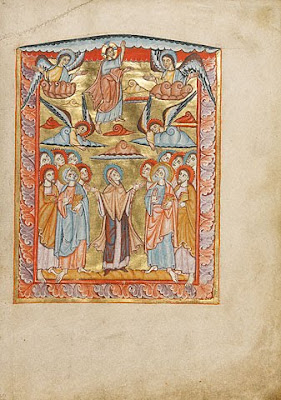Right Hand of the Father: Rediscovering the Ascended Life of Jesus (Introduction)
 One could argue that twenty-eight percent of the New Testament has the ascension of Christ as its central event and theological emphasis, yet it remains the most silent doctrine in modern evangelicalism. Two questions readily come to mind: “Why?” and “So What?” I will not spend too much time unpacking the former question; but with a pastoral heart, a theological mind, and an artistic fervor I will spend the rest of this book answering the latter.
One could argue that twenty-eight percent of the New Testament has the ascension of Christ as its central event and theological emphasis, yet it remains the most silent doctrine in modern evangelicalism. Two questions readily come to mind: “Why?” and “So What?” I will not spend too much time unpacking the former question; but with a pastoral heart, a theological mind, and an artistic fervor I will spend the rest of this book answering the latter.For years I only thought of Jesus in either past or future-tense terms. What I mean is my concept of Jesus was either as a crucified Savior who died on a cross to pay for my sins or as a white-robed horse rider coming back one day to take his children home. The doctrine of the atonement is vital to our faith and my understanding of it matured over the years. Likewise, my concept of Jesus’ return gained greater clarity through seminary training and exposure to other views of “end times.”
However, I still lacked one very important perspective of Jesus: his present ministry at the right hand of the Father. In all of my years as a Christian I don’t think I ever heard a sermon, a lecture, a Bible study, or a song on the doctrine and implications of the ascension of Christ. I had become well versed in Jesus' birth, his earthly life, his death, resurrection, and return; however, his ascended life was mostly a vague concept.
I’m guessing that, for most people, talking about what Jesus has done and will do would be easier than describing where he is and what he is doing right now. That is why I am writing this book. As I have pondered, read, prayed, written, and sung about the ascended life of Jesus over the past six years, I have come to see the richness, the irony, and the neglect of this important Christian doctrine and reality. I have come across narratives, psalms, exhortations, hymn fragments, early creedal statements, titles, and activities that I had never seen or understood in quite the same way. I have read commentaries on various passages that reveal a bias for the cross and the resurrection even though a clear reading and simple exegesis would reveal the ascension as the writer’s theological orientation.
I have noticed how the church still recognizes and pours much time and energy into the birth and resurrection of Christ each year during Christmas and Easter without any intentional planning or celebration for Ascension Sunday or Pentecost Sunday. My own personal library would reveal numerous books and chapters on the Christian life, the cross and the resurrection to the relative neglect of the doctrine of the ascension.
When one starts to put all of this together it’s no wonder why the present, ascended life of Jesus is such a vague, if not, foreign concept in the average Christian’s mind; yet, the irony is that it was central to both the New Testament authors and to the early church.
One place we see this is in the Apostle Paul’s first letter to the young Timothy. He is writing to encourage Timothy with wisdom and insight about a life of ministry. Midway through his correspondence he makes this statement: “Without question, this is the mystery of our faith.” And then he quotes what scholars believe to be an early hymn fragment; in other words, part of a song that the early church likely sung:
Christ was revealed in a human body
and vindicated by the Spirit.
He was seen by angels
and announced to the nations.
He was believed in throughout the world
and taken to heaven in glory. (I Timothy 3:16)
There is a poetic beauty and symmetry and a theological richness to this early hymn fragment. The series of couplets describe Christ’s incarnation; his revelation to this world; the presence of unseen realities; and, interestingly, his ascension to heaven. What is not described here is the cross, the resurrection, or the return of Christ. These are all vital to the faith, but in this early lyrical and creedal statement the life of Christ is summed up in his birth and his ascension.
How did we lose the doctrine of the ascension in the modern evangelical church? How did something so fundamental to our faith become obscured and neglected? I do not have all of the answers to those questions nor will I try to answer them. What I am completely passionate about, however, is the church rediscovering this neglected, yet fundamental doctrine of our faith. I long for pastors, professors, worship leaders, artists, and small group leaders to really take hold of expressing and imparting the ascended life of Jesus in their local churches, seminaries, and communities.
When I am leading worship or a small group study, sometimes I will mention that we should “learn to read the Bible in 3D.” What I mean by that statement is that I long for a person to use his or her imagination when reading Scripture. I long for a person to place oneself within the narrative and try as best as one can to understand the cultural and historical context.
I will try to do this with the hymn fragment from I Timothy 3:16 that I shared above. Ask yourself:
- Why did Paul choose to insert part of this song that the early church was singing?
- Did Paul start humming this song while he was writing his letter to Timothy?
- Had he gathered in a home church that day where that song was part of the worship?
- Who wrote the song in the first place and what was the inspiration for it?
With those questions in mind, imagine this scenario. Some scholars believe that this hymn fragment came from the “School of Stephen,” a body of teaching from Stephen one of the first Christian deacons and leaders, “a man full of faith and the Holy Spirit” (Acts 6:5), and the first Christian martyr. Now imagine some young songwriter sitting under this teaching. Maybe this individual had gathered in a home church on a Sunday to worship, heard someone teaching on the life of Christ, and went home to pen the lyrics to a new song.
Now imagine the Apostle Paul attending a home church somewhere (e.g., in Antioch, Ephesus or Philippi) and singing this new song that had begun to circulate among the early followers. Paul learns it and begins to sing it as part of his own personal worship and devotion. Then, one day, he decides to write a letter to a young leader in the church by the name of Timothy. About midway through his letter he decides to incorporate part of the lyrics to this song that we now have a record of and that is part of the inspired canon of Scripture.
Why do I share all of this? I do so partly to demonstrate how to approach the reading of Scripture with an informed imagination and creativity; however, I do so mainly to elucidate the following points about the role of art:
- Art helps open our eyes to the beauty and paradox of the Gospel.
- Art informs our theology; theology informs our art.
- Art becomes part of the language of our community.
No doubt, when sung, this early hymn fragment from I Timothy 3:16 helped stir the hearts and the minds of the early followers. Interestingly, in a relatively didactic correspondence to Timothy, the Apostle Paul chooses to incorporate a song to bring closure to his pastoral, ecclesial, and theological train of thought. And finally, these ancient lyrics had clearly become part of the affirmation of faith of the early church. In other words, in this early church community these lyrics had become part of the language for describing the “mystery of our faith.”
For this book I have decided to incorporate my own song lyrics for these same reasons. In my passion for helping believers today gain an “Ascended Christ” consciousness, I know that putting memorable words and melodies on people’s lips will only help my endeavor. Music is powerful. If people not only read the pages in this book, but begin to incorporate these songs into both personal and corporate worship, then the ascended life of Christ will slowly start to become part of the language of a given community of believers.
Including these songs is not a marketing ploy; it is actually the expression of a value I share deeply with my Anglican brothers and sisters: lex orandi, lex credendi – the law of prayer is the law of belief.
In other words worship, liturgy, lyrics, prayer, doctrine and belief are all closely connected. Our experience of worship is part of what forms and informs our faith and belief; thus, incorporating songs to be sung corporately in worship is a vital and intentional part of the organization and vision of this book. Hopefully, singing songs about the ascended life of Jesus will aid in the clarity and edification of both head and heart.
We desperately need to tell a larger story in modern evangelicalism, one that includes the present as well as the past and future realities of our faith. It is my hope and prayer that this book would be a step in that direction.



Comments